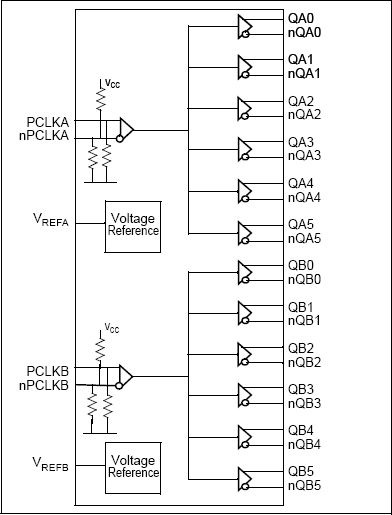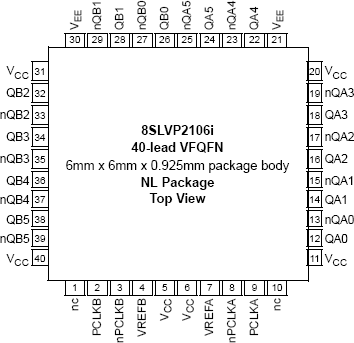Overview
Description
The 8SLVP2106I is a high-performance differential dual 1:6 LVPECL fanout buffer. The device is designed for the fanout of high-frequency, very low additive phase-noise clock and data signals. The 8SLVP2106I is characterized to operate from a 3.3V and 2.5V power supply. Guaranteed output-to-output and part-to-part skew characteristics make the 8SLVP2106I ideal for those clock distribution applications demanding well-defined performance and repeatability. Two independent buffers with six low skew outputs each are available. The integrated bias voltage generators enables easy interfacing of single-ended signals to the device inputs. The device is optimized for low power consumption and low additive phase noise.
Features
- Two 1:6, low skew, low additive jitter LVPECL fanout buffers
- Two differential clock inputs
- Differential pairs can accept the following differential input levels: LVDS and LVPECL
- Maximum input clock frequency: 2GHz
- Output bank skew: 12ps (typical)
- Propagation delay: 280ps (typical)
- Low additive phase jitter, RMS: fREF = 156.25MHz, VPP = 1V, 12kHz - 20MHz: 49fs (typical)
- Full 3.3V and 2.5V supply voltage modes
- Maximum device current consumption (IEE): 100mA (typical)
- Available in Lead-free (RoHS 6), 40-Lead VFQFN package
- -40°C to 85°C ambient operating temperature
-
Supports case temperature ≤105°C operations
Comparison
Applications
Design & Development
Models
ECAD Models
Schematic symbols, PCB footprints, and 3D CAD models from SamacSys can be found by clicking on products in the Product Options table. If a symbol or model isn't available, it can be requested directly from the website.

Videos & Training
Description
Overview of IDT's 8LSVP (LVPECL) and 8SLVD (LVDS) families of low-jitter fanout buffers from IDT. Fanout buffers are a useful building block of many clock trees, providing signal buffering and multiple low-skew copies of the input signal. IDT's high-performance, low additive phase noise, differential clock fan-out buffers offer up to 2 GHz clock operation, low additive phase jitter (12kHz - 20MHz) of 50 to 100 femtoseconds RMS max, fast output rise & fall times (less than 150ps), and single and dual channel functions (dual: matched propagation delay). Presented by Baljit Chandhoke, Product Marketing Manager at Integrated Device Technology, Inc. To learn more about IDT's industry-leading portfolio of fanout buffers, visit Renesas's RF Buffer page.
Transcript



